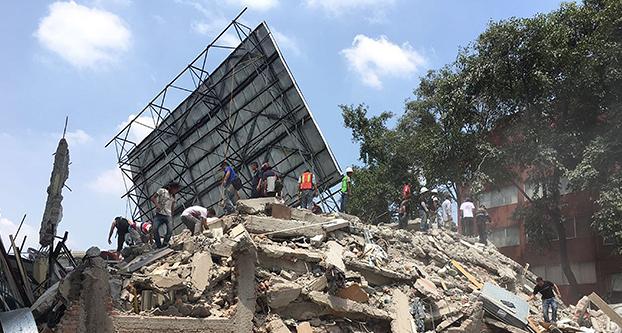By Kate Linthicum, Rong-Gong Lin II and Alexandra Zavis
A powerful 7.1 earthquake shook central Mexico on Tuesday, collapsing homes and bridges across hundreds of miles, killing at least 105 people and sending thousands more fleeing into the streets screaming in a country still reeling from a deadly temblor that struck less than two weeks ago.
By 12 a.m. on Wednesday morning, media reports said the death toll was nearly 250 across the country
In Mexico City alone, at least 30 people died and 44 buildings were severely damaged Tuesday, said Carlos Valdes, director of Mexico’s National Center for the Prevention of Disasters. Seven other people were reported killed in the surrounding state of Mexico, 26 in the state of Puebla and 42 across the state of Morelos.
The earthquake caused apartment blocks to sway violently in the center of Mexico City, including in the historic districts of El Centro and Roma, crumbling balconies and causing huge cracks to appear on building facades.
Panic spread through the city’s core; rescue vehicles screamed toward damaged buildings, and neighbors took on heroic roles as rescuers.
On Amsterdam Street, a normally tranquil road that rings a major park in the upscale neighborhood of Condesa, a large apartment building collapsed into a pile of concrete and dust.
Hundreds of residents helped a team of soldiers, police officers and firefighters search the rubble for survivors. Many of the men were shirtless in the late summer heat, and everyone was covered with dust.
Some rescuers commandeered shopping carts from a nearby supermarket and formed a human chain to haul away rubble. Several times, a warning went up about a possible aftershock or gas leak, sending hordes of panicked people running.
But there were few places that would be safe. Amsterdam, like many streets in Condesa, is narrow and lined with trees and power lines, all of which could turn deadly in an aftershock.
The neighborhood was filled with thousands of dazed survivors too afraid to return to their homes. They stood around with dogs and suitcases, holding their heads and checking social media feeds on their phones. Many ducked into their apartments to bring food and water for rescuers.
Like many in the city, Edgar Diaz, a 20-year-old architecture student at a university in Condesa, took part in an earthquake drill at 11 a.m. Hours later, the real one hit.
“We all went running. The staircases were swaying,” he said.
After establishing that his friends were all right, he joined the line of people helping clear rubble from the collapsed apartment building.
“What’s important right now is saving lives,” he said.
Juan Jose Martinez, 52, felt the temblor at his home several miles away. There was no damage to his neighborhood, so he and three relatives grabbed shovels and construction helmets and set out on foot to the most affected areas.
“What else would we do?” he said. “This is our Mexico. Everybody needs help sometimes.”
Police cordoned off entire blocks because of fears that gas leaks could cause explosions.
Flights into Mexico City were temporarily rerouted to other cities, but the airport reopened after checks were completed.
Most people were at work or at school when the earthquake hit. Across the city, they poured into the streets to walk home, searching for information about loved ones and posting the names of the missing on trees and lampposts.
Public transportation had ceased to function in a sprawling city so large it can take three hours to get home.
“It’s very horrendous,” said Guillermo Lozano, the humanitarian and emergency affairs director for World Vision Mexico, a Christian humanitarian organization. “Everything was moving. The stairs were moving, things were falling down.”
Among the destroyed buildings was a supermarket where survivors could be heard crying out for help, he said.
There were also reports that a kindergarten had collapsed, trapping children under the debris. Staff members at a children’s hospital were tending to patients in the streets.
Building standards have improved since the 1985 quake, Lozano said, but there are many old buildings in the city, which were among the worst-hit.
For a country still recovering from a powerful earthquake that hit southern Mexico on Sept. 7, it was a double tragedy. “We will need a lot of help,” Lozano said.
News of the latest disaster spread fear across the republic.
Mariela Alvarez, 30, was getting her nails done in San Vicente in the coastal state of Nayarit when she heard about the earthquake. She immediately thought of her 25-year-old sister, Gabriela Alvarez, who has lived in Mexico City for about five years.
She called her sister five times, growing more and more nervous every time she got her voicemail. “I imagined terrible things,” Mariela said. “I was really scared.”
She reached out to her father, who was at work. He told her that he had heard from Gabriela. She was fine.
“We could talk to her and so we feel calm, but there are people who still don’t know,” Mariela said.
As night fell, volunteers carried food, water, flashlights and other basics to people camping out in streets still littered with glass and debris.
Mexico City is prone to major damage in earthquakes because it sits on an old lake bed that amplifies the shaking.
The U.S. Geological Survey calculated the preliminary magnitude of Tuesday’s temblor at 7.1. The epicenter was about 80 miles southeast of Mexico City in the state of Puebla.
Susan Hough, a USGS seismologist, said the quake was probably related to the one that struck off the coast of Mexico’s Oaxaca state on Sept. 7, which the government calculated as a magnitude 8.2 and her agency as an 8.1.
“An 8.1 is big enough that having an aftershock this big and this distant, it isn’t too surprising,” Hough said. “It’s unusual, but it fits in with the picture that we’ve grown to understand.”
Jessica Johnson contributed to this story.




